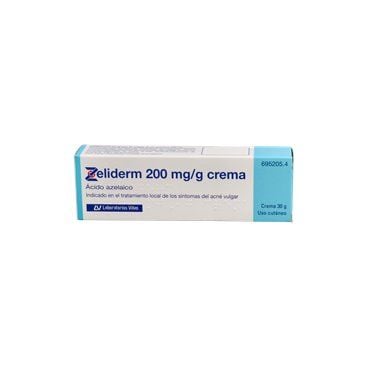Zeliderm 200 Mg/G Cream 30 G
Zeliderm acts at the same time against three important factors that intervene in the acne process: a) excessive sebum secretion, b) plugging of the follicle channel due to excess keratin and c) microbial colonization. It is indicated in the local treatment of the symptoms of acne vulgaris.
Zeliderm acts at the same time against three important factors that intervene in the acne process: a) excessive sebum secretion, b) plugging of the follicle channel due to excess keratin and c) microbial colonization. It is indicated in the local treatment of the symptoms of acne vulgaris.
Zeliderm (200 Mg / G Cream 1 Tube 30 G)
ACTION AND MECHANISM
- Anti-acne. Azelaic acid is a natural dicarboxylic acid with keratolytic and antibacterial activity. It inhibits the proliferation of keratinocytes and normalizes the epidermal differentiation process, which is altered in patients with acne. In addition, a decrease has been clinically demonstrated to reduce colonization by Propionibacterium acnes, also decreasing the levels of free fatty acids in skin lipids.
PHARMACOKINETICS
- Absorption: after topical application of azelaic acid, it has the ability to penetrate all layers of the skin. Despite this, its systemic absorption is <4%.
- Metabolism: the absorbed fraction is partially metabolized by beta-oxidation, generating short chain dicarboxylic acids (C5-C7).
- Elimination: both azelaic acid and its metabolites are excreted in urine.
INDICATIONS
- Treatment of mild to moderate papule-pustular [ACNE] on the face.
POSOLOGY
"ZELIDERM"
- Adults: apply a layer on the affected area, twice a day. It usually takes about 2.5 cm to cover the entire face.
If severe irritation occurs, it may be necessary to decrease the amount administered, reduce the dose to one daily application, or temporarily suspend treatment until the irritation subsides.
Usually 4 weeks of treatment are required to see improvement in symptoms, although treatment may need to be prolonged up to 12 months to achieve complete remission.
If acne does not improve after 1 month of treatment, or an exacerbation occurs, the need to seek other therapeutic alternatives will be considered.
- Children and adolescents <18 years:
* Adolescents from 12 years old: the same as adults.
* Children <12 years: its use is not recommended.
Missed dose: administer the next dose at the usual time. Do not double the next dose.
RULES FOR CORRECT ADMINISTRATION
Before administration, clean the face with water (a mild soap can also be used), and dry it.
Apply to the affected area, giving a gentle massage. Do not use occlusive dressings or bandages on the application area.
Wash your hands after administering the medicine.
CONTRAINDICATIONS
- Hypersensitivity to azelaic acid or any other component of the drug.
PRECAUTIONS
- [ASTHMA]. Azelaic acid has been linked to the onset of asthma attacks.
- Avoid contact with the eyes and mucous membranes. In case of accidental contact, wash with water.
- Avoid the use of aggressive cleaning agents.
ADVICE TO THE PATIENT
- Wash your face with water before administration.
- Apply on the affected area, giving a gentle massage.
- The lesions should not be covered with dressings or bandages.
- Wash your hands after you have finished giving the medicine.
- The effects may take up to 4 weeks to appear. However, several months of treatment may be necessary to obtain the maximum effects.
- Avoid contact with eyes and mucous membranes. If accidental contact occurs, wash with water.
- Do not use aggressive cleaning agents during the treatment, as they can worsen the symptoms.
- In the event of severe irritation of the face, it may be necessary to decrease the amount administered, reduce the dose to one daily application or temporarily suspend treatment.
- If acne symptoms do not improve after 1 month of treatment or if they get worse, consult your doctor and / or pharmacist.
SPECIAL WARNINGS
- If acne symptoms do not improve after 1 month of treatment or worsen, other therapeutic alternatives should be considered.
INTERACTIONS
No specific studies have been conducted.
PREGNANCY
Safety in animals : studies in rats and rabbits using doses 150-2500 times higher than human therapeutics showed embryotoxic but not teratogenic effects.
Safety in humans : There are no adequate and well-controlled studies in humans. Data on a limited number of exposures during pregnancy (n = 2) do not indicate adverse effects of azelaic acid on pregnancy, or on the health of the fetus / newborn. Its administration is only accepted if there are no safer therapeutic alternatives, and the benefits outweigh the possible risks.
Effects on Fertility : No specific studies have been performed in humans.
LACTATION
Animal safety: no data available.
Safety in humans: it is not known if it is excreted with milk, and the consequences it could have for the infant. Taking into account that the systemic absorption is <4%, it is not expected that it can have significant effects on the infant. Caution is advised.
It is not intended for application on the breasts. The infant should not be put in contact with the treated areas.
KIDS
The safety and efficacy for the treatment of acne in children <12 years have not been evaluated, therefore it is recommended to avoid its use.
SENIORS
No specific problems have been described in the elderly.
EFFECTS ON DRIVING
It does not appear to have a significant effect on the ability to drive.
ADVERSE REACTIONS
At the beginning of the treatment, especially in people with more sensitive skin, local irritation may appear in the areas of application. The irritation is usually mild and self-limited. If the irritation is intolerable for the patient, it usually responds to a reduction in the dosage or to the suspension of treatment for several days.
Adverse reactions are described according to each frequency range, being considered very common (> 10%), common (1-10%), uncommon (0.1-1%), rare (0.01-0.1%) , very rare (<0.01%) or of unknown frequency (cannot be estimated from the available data).
- Respiratory: rare [ASTHMA].
- Dermatological: very frequent [SKIN IRRITATION] with pain, burning sensation or [ITCHING]; frequent [EXANTEMATIC ERUPTIONS], [PARESTHESIA], [DRY SKIN] or [SKIN EDEMA]; uncommon [ERITHEMA], [SKIN SCALING], [URTICARIA], skin discoloration, [CONTACT DERMATITIS] or [ACNE] worsening.
- Allergic: very rare [HYPERSENSITIVITY REACTIONS] cutaneous.
ADVERSE REACTIONS RELATING TO EXCIPIENTS
- Because it contains methyl parahydroxybenzoate, it can cause [HYPERSENSITIVITY REACTIONS] (possibly delayed).
- This medicine contains propylene glycol, so it can cause [SKIN IRRITATION].
- Because it contains propyl parahydroxybenzoate, it can cause [HYPERSENSITIVITY REACTIONS] (possibly delayed).
OVERDOSE
Symptoms: azelaic acid has low toxicity, which together with its low systemic absorption makes a clinically significant overdose unlikely.
Measures to be taken: symptomatic treatment.
Zeliderm 200 Mg / G Cream 1 Tube 30 G Leaflet



